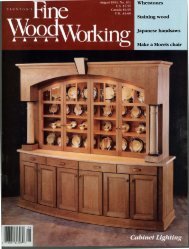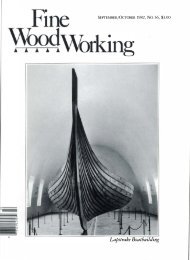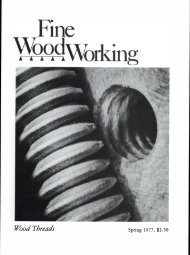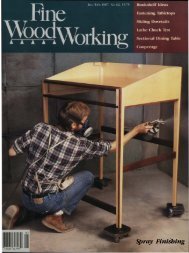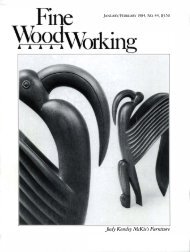NOVEMBER/DECEMBER 1983, No. 43, $3.50 Making ... - Wood Tools
NOVEMBER/DECEMBER 1983, No. 43, $3.50 Making ... - Wood Tools
NOVEMBER/DECEMBER 1983, No. 43, $3.50 Making ... - Wood Tools
You also want an ePaper? Increase the reach of your titles
YUMPU automatically turns print PDFs into web optimized ePapers that Google loves.
Spoon Bits<br />
Putting 17th-century high technology to work<br />
by David Sawyer<br />
For the last couple of years, Conover <strong>Tools</strong> has been selling<br />
a set of eight spoon bits and a tapered reamer in a neat<br />
canvas roll. They are copies, made in Taiwan, of a fine old set<br />
in Michael Dunbar's Windsor chairmaking toolkit. The bit<br />
sizes are six, seven, eight, nine, ten, eleven, twelve and sixteen<br />
sixteenths, with spoons about 2% in. long. The reamer tapers<br />
a hole at a 10° included angle, quite useful for chair leg-toseat<br />
joints-although I'd prefer 8°, since 10° barely "sticks."<br />
As bought, 'these spoons are straight-sided doweling bits,<br />
which were a mainstay for many craftsmen, such as coope(s<br />
and brushmakers. Chairmakers either used the bits straight,<br />
as in Dunbar's set, or modified them into duckbill bits for<br />
boring the large-bottomed mortises found in so many old<br />
green-wood chairs. John Alexander, author of Make a Chair<br />
from a Tree (Taunton Press), explains the advantages of this<br />
joint on p. 72. Old-timers also used open-end spoon bits,<br />
called shell bits, which look almost like "ladyfinger" gouges.<br />
They are easier to sharpen than spoons, and CUt nearly as well,<br />
even in dry hardwood chair backs. This is forrunate, since a<br />
used-up spoon bit will become a shell bit.<br />
When you first unroll Conover's bits, they're beautiful.<br />
Upon closer inspection, they're kind of lumpy and bumpy,<br />
apparently finished in a hurry with a belt sander. Fear notwith<br />
a little tinkering and sharpening, they will work just<br />
fme. A lot of folks object to having to rune up new tools, but<br />
I fmd that this is a great way to learn all about the tools and<br />
make them truly your own.<br />
70<br />
__ __ __ Any<br />
At left, a Windsor chairmaker's toolkit.<br />
The 'hardwood hole gauge provides references<br />
when sharpening. Lined up from left<br />
to right are the sharpening scraper, four<br />
spoon bits for mortises, a tapered reamer<br />
jor leg-to-seat joints, and an old shell bit<br />
for back spindles. As shown above, bits are<br />
soft enough that you can sharpen them<br />
easily by scraping with an old file honed<br />
to a keen edge. They are tough enough to<br />
remain sharp for a few dozen holes.<br />
How a spoon bit cuts-The spoon bit cuts on only one side<br />
of its semicircular lip. <strong>No</strong> other part needs sharpening. The<br />
cylindrical portion guides on its outside, clears chips on its<br />
inside, and must not have a diameter greater than the cutting<br />
edge, to avoid binding or reaming a tapered hole.<br />
cutting edge must have some<br />
relief on its underside. What I call the<br />
"lead" of a cutting tool would be the<br />
progress per revolution in a drill or a<br />
----<br />
reamer, or the thickness of the shaving<br />
a plane takes. For a plane, lead is regulated<br />
by how far the blade projects<br />
beneath the sole; for an auger bit, it is<br />
regulated by the leadsaew. A machinists'<br />
twist drill is like a spoon bit with<br />
a straight cutting edge, and if you can<br />
visualize how it cuts and how it is<br />
sharpened, this will help you understand<br />
the spoon. Try to imagine the<br />
spiraling development of the hole and<br />
the bit following it. In a spoon bit,<br />
lead depends entirely on how much relief you-grind into it-if<br />
too much, the bit gets too hungry. The relief space shown<br />
above is exaggerated for clarity. It will be gradually used up<br />
as the bit is resharpened, and then the outside must be reshaped.<br />
The bearing surface gives stability in the hole.<br />
As we all know, you can force a dull twist bit, or one that



